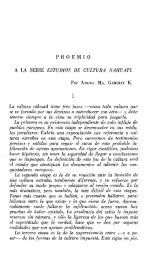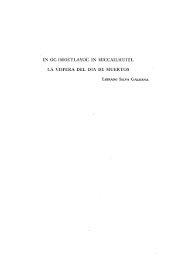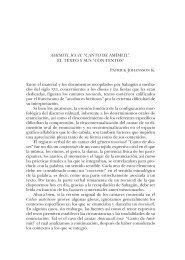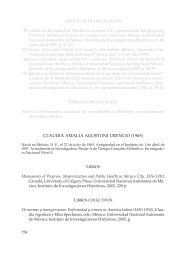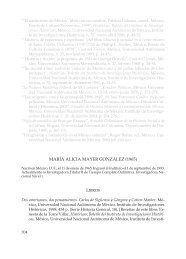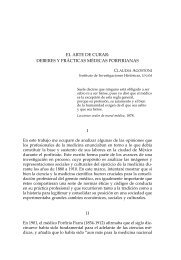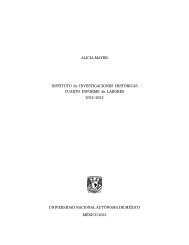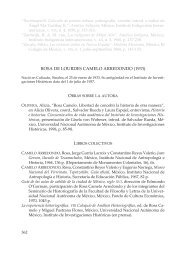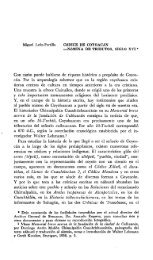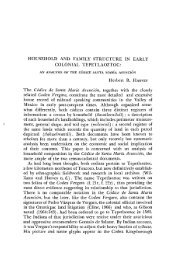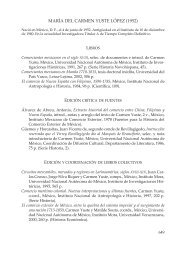HE COULD HAVE MADE MARVELS IN THIS lANGUAGE
HE COULD HAVE MADE MARVELS IN THIS lANGUAGE
HE COULD HAVE MADE MARVELS IN THIS lANGUAGE
Create successful ePaper yourself
Turn your PDF publications into a flip-book with our unique Google optimized e-Paper software.
"<strong>HE</strong> <strong>COULD</strong> <strong>HAVE</strong> <strong>MADE</strong> <strong>MARVELS</strong> <strong>IN</strong> <strong>THIS</strong> <strong>lANGUAGE</strong>"<br />
A NAHUATL SERMON BYFAT<strong>HE</strong>RJUAN DE TOVAR, SJ.<br />
BARRYD. SEU.AND LARIssATAYLOR<br />
DEDICATED TO CHARLES E. DmBLE<br />
The following commentary on a little-known Nahuatl text of the<br />
early seventeenth century is divided into two parts, each ref1ecting<br />
the differing backgrounds and interests of the authors. The first<br />
part places the piece in the context of the Nahuatl corpus associated<br />
with the church and was done by Sell. The second touches on the<br />
very important question of its European antecedents and contemporary<br />
counterparts and was written by Taylor. The document itself<br />
can be found in full transcription and English translation at the<br />
end of this essay.l<br />
A. T<strong>HE</strong> MEXICAN CONTEXT<br />
The Dominican nahuatlato (expert in Nahuatl; translator) fray Marun<br />
de León in the prologue to his sermonary of 1614 listed those<br />
whom he considered the more accomplished authors of indigenous-language<br />
publications. Among this distinguished company<br />
were a number of nahuatlatos. They included the Franciscans fray<br />
Alonso de Molina and fray Juan Bautista, and the Augustinians<br />
fray Juan de la Anunciación and fray Juan Mijangos. León says<br />
abouttheJesuits:<br />
Everyday things of diverse 1anguages come out of the great Society of<br />
JESUS and they could do much with this on account of having marvelous<br />
subjects, for if Father Juan de Tovar (rector of the College of<br />
Indians of Saint Gregory) would have applied himself [to writing<br />
1 Note that all abbreviations in the Nahuad. Latin and Spanish have been resolved.<br />
Transcription and translation of the Spanish and Nahuad are the responsibility of Barry D.<br />
Se1l. Norrnalization of Latin spe1lings and translations of sarne courtesy of Stafford Poole.<br />
C.M.. to whom I extend my sincere gratitude for his generous help.
212 BARRY D. SELL AND lARISSA TAYLOR<br />
books] he could have made maIVels in this language, although he is<br />
very weU occupied (instead] in teaching virtue, science and music of<br />
all instruments to his Indians.2<br />
Several decades later Father Horacio Carochi, the greatest colonial<br />
grammarian of Nahuatl who rarely praised anyone, would laud<br />
Tovar as being ..eminent in this language. ""<br />
Perhaps the greatest compliment paid to Tovar's abilities was<br />
made more than a century after his death in circa 1623. In the mideighteenth<br />
century Father Ignacio de Paredes evaluated more than<br />
200 years of alphabetical Nahuatl texts. He mentions by name only<br />
seven outstanding experts, among them Tovar, in the last published<br />
Nahuatl sermonary of the colonial period:<br />
In the language [ of this book] I have tried to use the purest, most appropriate<br />
and most genuine words, [the same] that the most eminent<br />
and classical authors of the discipline used: as are the Bautistas, the<br />
Molinas, the Mijangos's, the Leones, Anunciación, the Carochis and<br />
Tovares, with others [who were] native [speakers] of the language,<br />
who left us their books (whether printed or manuscript) that conserve<br />
in their propriety and elegance this fecund and extremely elegant language.<br />
And I have left out on purpose other words that are [currently]<br />
used in some places on account of being in reality barbarous and<br />
never found in these most celebrated masters of the language.4<br />
Tovar.s facility in Nahuatl also is well attested by his role as an<br />
expert examiner of Nahuatl manuscripts destined for the press.<br />
Except for Maestro (and then Doctor) Hernando Ortiz de Hinojosa<br />
2 "De la gran Compañia de IESVS, salen cada dia cosas de diuersas lenguas, y desta pudieran<br />
hazer mucho por tener sujetos maruillosos. Que si el Padre loan de Tobar Rector del<br />
Colegio de los Indios de San Gregorio, se vuiera aplicado, pudiera auer hecho marauillas en<br />
esta lengua, aunque esta muy bien occupado enseñando a sus indios virtud, sciencia, y musica<br />
de todos instrumentos" (~ón 1614, preliminary leaf, unnumbered) .<br />
3 Carochi 1645, 75v. Note that the only other nahuatlatos that he mentions by name in<br />
the body of his grammar are his fellow jesuit, Father Antonio del Rincón (whose faults he<br />
generously excuses, e.g., see 58r and 81r-v) , and the Franciscan lexicographer fray Alonso de<br />
Molina (about whom he makes slighting remarks, e.g., on 3r). NotWithstanding a decided<br />
favoritism towardsjesuits, Carochi's estimate ofTovar was merited.<br />
4 "En el Idioma he procurado usar de las voces mas puras, proprias, y genuinas, que<br />
usaron los mas eminentes, y classicos Autores de la facultad: como son los Baptistas, los Molinas,<br />
los Mijangos, los ~ones, Anunciacion, los Carochis, y Thobares, con otros naturales en<br />
el Idioma, que nos dejaron sus Libros, ó impressos, ó manuscritos; que conservan en su propriedad,<br />
y elegancia este fecundo, y elegantissimo Idioma. y de proposito he omitido otras<br />
voces, que se usan en algunos lugares; por ser en la realidad barbaras, y que jamas se hallan<br />
en estos celeberrimos Maestros del Idioma" (Paredes 1759b, "Razon de la obra al lector",<br />
preliminary leaf, unnumbered).
A NAHUATL SERMON BY FAT<strong>HE</strong>RJUAN DE TOVAR S.J<br />
213<br />
he reviewed more high-quality texts than any other official censor<br />
of the colonial period. His seal of approval appears in Molina ts revised<br />
grammar of 1576 and his Doctrina cristiana of 1578, Bautista 's<br />
collection of pre-Hispanic high oratory of 1600 and his sermonary<br />
of 1606, León's eclectic Camino del cielo of 1611 and Mijangos' sermonary<br />
of 1624. .<br />
Tovar is perhaps best known today for being a prestigious early<br />
recruit to the Society ofJesus (they first arrived in Mexico in 1572)<br />
and for various writings about Nahuas. Modern scholars are almost<br />
totally unaware that an extant Nahuatl text by him was widely available<br />
to his colonial contemporaries.5 When the nahuatlato Mijangos<br />
published his sermonary in 1624 he included a sermon by<br />
Tovar on the Most Holy Sacrament "because I wanted to know how<br />
I might properly speak about the [ external] appearances of [ consecrated]<br />
bread and wine."6<br />
One of the most unusual features of the sermon is Father Tovarts<br />
direct reference to his own parish. "Here", he proclaims at the<br />
beginning of his speech, "in San Sebastián Atzaqualco", the very<br />
"tlaxilacalli and childhood home of Moteuczomatzin. "7 I have examined<br />
all the published and some of the manuscript colonial<br />
Nahuatl sermonaries and (unintentional omissions aside) have yet<br />
to come across another such specific reference to an individual Nahua<br />
congregation.8 This was due in large part to the pronounced<br />
tendency of authors to make their sermons acceptable in many different<br />
Nahua altepetl (cit[y/ies, realm[s]). On any given Sunday or<br />
feast day, however, many clerics surely added the names of the tlaxilacallis<br />
(barrios, districts, wards [i.e., chief colonial subdivisions of<br />
an altepetl] ) in which they preached and of their patron saints. At<br />
the very least Tovar did so, and Mijangos undoubtedly intended the<br />
readers of his sermonary to understand that where Tovar mentioned<br />
his specific parish they were to substitute the terms appropriate<br />
to their own circumstances.<br />
5 I leave out of consideration tbe translations from Spanish into Nahuatl made by Tovar<br />
for Archbishop Moya de Contreras which supposedly were published under the title El<br />
catecismo y diálogvs (circa 1573). At present I am aware of no exisiting copy of this work so it<br />
cannot be compared to tbe text under discussion here.<br />
6 Appendix I. this article, lines 1-3; hereafter referred to as .Lines [fi11 in the<br />
number]..<br />
7 Unes 9-11; edited for purposes of presentation.<br />
8 Such references also are equalIy rare in tbe genera1 run of colonia1 Nahuatl imprints.<br />
One of the very few (and only a partial one at that) is in a model testament: the parish of<br />
Santa María Asunción [ of an unnamed tlaxilacalli] of tbe altepetl of Tetzcoco (Molina 1984<br />
[1569] .61r).
2}4 BARRY D. SELL AND I.ARISSA T AYLOR<br />
More common in the sermon genre are broader references like<br />
Tovar's mentions of Mexico City and his direct address to "you Mexica.<br />
"9 The Mexica Tenochca were the Nahuas native to Mexico<br />
Tenochtitlan (later colonial Mexico City) who had run the Aztec<br />
tribute empire; it was to this Nahua grouping that "Montezuma" belonged.<br />
Occasionally such general allusions were left in published<br />
collections of Nahuatl sermons, betraying where the official center<br />
of Nahuatl scholarship, preaching and printing (like so much else<br />
in coloniallife) was located or at least where the authors were mentally<br />
placing their censored versions of correct preachable material.<br />
Anunciación in his sermonary of 1577 first directs himself to "yn<br />
nican Mexico in annahuatlaca" (you Nahua peoples here in Mexico<br />
[City]]) and later to "yn nican anchaneque, yn anMexicotlaca"<br />
(you local residents, you [Nahua?/Indian?]<br />
peoples of Mexico<br />
[City]).lO León in his sermonary of 1614 addresses himself to "in<br />
anMexica, in antenochca in nepapan antlaca" (you Mexica, you Tenochca,<br />
and you various [ other ] peoples/you various Mexica and<br />
Tenochca peoples) .11<br />
Mijangos would go them one better in his sermonary of 1624.<br />
He does not specifically mention one Nahua group in any particular<br />
sermon; rather, he dedicates his whole book to the natives of<br />
Mexico Cityl Following the expected "Aduertencias al Lector" for<br />
Spanish speakers he has a five-page prologue in Nahuatl directed to<br />
his Nahua readers: "BEHOID T<strong>HE</strong> BOOK BELONG<strong>IN</strong>G TO and that will<br />
be read [by] the Mexica, the Tenochca and all those who speak Nahuatl,<br />
who pronounce the language of the Mexica and make their<br />
homes everywhere here on the earth of our Lord God. "12 He then<br />
begins his remarks by proclaiming "Tla~otlacae in anMexica" (O<br />
dear people, you Mexica/O you esteemed Mexica peoples). He<br />
ends with "Onitlacuilo, nican Mexico Tenochtitlan in nehuatl, yn<br />
amoteopixcauh. Fr. luan de Mijangos" (I, your priest fray Juan de<br />
Mijangos, did the writing here in Mexico Tenochtitlan [i.e., the place<br />
ofthe Mexica Tenochca]).13<br />
9 Lines 35-38.<br />
10 Anunciación 1577. 59r and 64r. respectively. Note that he closes one seffi1on with<br />
"yn nican Mexico" (here in Mexico [City])[ibid., 178v].<br />
11 León 1614. 49r. Note again local references such as "nican Mexico" (here in Mexico<br />
[City] ) and "Mexicadalpan " (in the land of the Mexica) [ibid., 57r and 99v. respectively] .<br />
12 "IZCATQVI <strong>IN</strong> AMATZ<strong>IN</strong>1U <strong>IN</strong>1EZ<strong>IN</strong>CO [sic] POHVI. quimopohuilizque in Mexica. in tenochca<br />
yhuan in ixquichtin in nahuadahtohua. in quimotenquixtilia in Mexicadahtolli. in<br />
nohuiarnpa modachantilitoque nican ydalticpactzinco toTecuiyo Dios" (Mijangos 1624. prelimina!"y<br />
leaf. unnumbered).<br />
13 lbid., preliminary leaves. unnumbered.
A NAHUA1L SERMON BY FAT<strong>HE</strong>R]UAN DE TOVAR S.].<br />
215<br />
Tovar's adaptation to local circumstances went far beyond including<br />
the name of his parish. He re1ied heavily on the devices of<br />
the traditional Nahua oratory known as huehuetlahtolli, somewhat literally<br />
meaning "the old word" but more properly understood as<br />
"speeches/admonitions of the elders" or "ancient discourse." The<br />
translators and editors of the most extensive collection of such<br />
harangues, Book Six of the Florentine Codex, sum up its principal features<br />
as being "extreme formality, floridness, ceremoniousness,<br />
effectiveness in command of figures of speech and recourse to parallelism,<br />
balance and repetitions. "14 This also accurately describes<br />
the Nahuatl of Tovar's text, although his syntax is considerably more<br />
complex at times than that found in other sermon collections. In<br />
addition Tovar has more of a propensity than most other clerics to<br />
use Nahuatl's inherent ability to construct complex nominal compounds,<br />
a tendency that did not go unnoticed by the greatest colonial<br />
grammarian of Nahuatl.15 When nahuatlatos like Tovar<br />
properly created and used compounds the Nahuatl was considered<br />
..smoother and more sonorous. "16<br />
Tovar was not afraid to borrow from other Nahuatl genres besides<br />
the huehuetlahto11i per se. In one passage San Juan "scatters<br />
down celestia11y precious words" and "declares precious gem-like<br />
words, a11 divinely dazzling sun beams"; elsewhere "fine words drizzle<br />
and scatter down as if they were radiant dew and painted gold<br />
pendants."17 This is very far from standard clerical Nahuatl. Even in<br />
the Bancroft Dialogues (Iessons in polite upper-class metaphorical<br />
Nahuatl) there is talk of tears sprinkling and scattering down but<br />
not ofwords.18 Tovar's stylized passages are far more reminiscent of<br />
song/poetry, although not the heavily Christianized original compositions<br />
found in fray Bernardino de Sahagún's Psalmodia cristiana<br />
(1583; 1993). The nearest parallels seem to be with material in the<br />
Cantares Mexicanos, the most extensive extant collection of seemingly<br />
pre-Hispanic-style Nahuatl song/poetry. There the items most<br />
often being scattered down, for example, are flowerlike or flowers,<br />
sometimes in the company of songs.19 The leap from "songs" to<br />
"words" scattering down is not too difficult to imagine, and Tovar<br />
14 Sahagún 1969.1. note 1.<br />
15 Carochi 1645. 75v.<br />
16 Ibid. See also similar remarks in Rincón 1595. 5Ov.<br />
17 Lines 40-43 and 81-85. respectively. The citations are considerably edited for purPOses<br />
of presen tation.<br />
lB Karttunen and Lockhart 1987, 130-133.<br />
19 For one example see Bierhorst 1985,208-209.
216 BARRY D. SELL AND lARISSA TA\1.0R<br />
may well have seen the Cantares or similar material, but there is<br />
only enough evidence to suggest that Tovar was borrowing from the<br />
genre and not necessarily from this particular source.<br />
For all of Tovar's expert and generous use of many of Nahuatl's<br />
expressive resources the actual content of the sermon is relatively<br />
disconnected from Nahua life, seemingly defeating the need clerics<br />
felt to adapt Christian teachings to Nahua sensibilities. Perhaps this<br />
was due in part to the nature of the genre itself where the same<br />
doctrinal points were relentlessly emphasized and repeated (perhaps<br />
to the point of boring regularity) as well as to the unceasing<br />
pressure put on all colonial nahuatlatos to stick to the safest authorities<br />
and examples available, i.e., stock biblical ones. The very<br />
technical nature of the issue being addressed surely added mightily<br />
to the abstractness of his presentation. An earlier piece by Anunciación<br />
on the very same Latin thema (text), on the other hand, yields<br />
a very different impression.<br />
For the feast day of the Most Holy Sacrament the Augustinian<br />
nahuatlato based his sermon onJohn 6:56-57: "MY BODY IS TRULY<br />
food and my blood is truly drink. He who eats my body and drinks my blood<br />
abides in me and I in him."20 Here is one of Anunciación 's explanations<br />
of the difference between consecrated and unconsecrated<br />
bread:<br />
o MY BELOVED CHILDREN, you already know how it happens here on<br />
earth, for in the homes of the nobles and rulers the tortil1as that are eaten<br />
are of two types. The first type of food is known as fine ground<br />
and pure, necessary for the rulers and lords, called pure tortillas. But<br />
the second type of tortilla is just fuU of ~shes, not very good, not very<br />
pure, nor is it very fmely ground; it is called tribute tortilla, crumbly,<br />
necessary for the palace messengers and for the lowly household dependents<br />
of the rulers. Likewise it spiritually happens, for the tortiUas<br />
our Lord GOD gives His children and His creatures are of two types.<br />
The first one is things of this earth, regarded as tribute tortillas, crumbly,<br />
spiritually not very delicious, not very strengthening, not very satisfying<br />
nor very consoling. It is necessary for those who desire the things<br />
of the earth who do not recognize the food of Heaven as being tasty<br />
and sweet. But the second one is called spiritual food, is very pure,<br />
very well prepared, very delicious and fragrant, very redeeming, very<br />
strengthening in a spiritual manner, and it makes people live healthi-<br />
20 "CARO MEA, VERE 6$t cibus: et sanguis meus vere 6$t potus. Qui manducat meam carnem, et<br />
bibit meum sanguinem, in me manet et ego in iUo. Ioannis capite 6(:56-57). (Anunciación 1577.<br />
84r) .Normalization of Latin spellings and translation courtesy of Stafford Poole. C.M.
A NAHUA11. SERMON BY FAT<strong>HE</strong>R]UAN<br />
DE TOVAR S.].<br />
217<br />
ly; it strengthens, raises, and con soles people's spirits and people's<br />
souls. This food is the precious body of our Lord JESUS CHRIST .21<br />
Here is a much more transparent example of Nahuatlization<br />
and shows how closely clerics could draw abstract doctrine and concrete<br />
example together in a (seemingly) effective analogy. It should<br />
be noted that the same term is used by Tovar for "bread" and by<br />
Anunciación for "tortilla." Nahuatl tlaxcalli meant "maize tortilla"<br />
and early in the colonial period added the sense "[Spanish-style]<br />
bread," the exact translation depending on context.<br />
While the term may be the same in both sermons the manner<br />
in which the two priests tied it to their parishioners' life experiences<br />
differed drastically. This was not a matter of expertise in the language<br />
but perhaps in part a matter of presentation (and see Taylor's<br />
comments below). Anunciación took a more general approach to<br />
his subject and so had more f1exibility in how he presented it to his<br />
audience; Tovar (apparently under Mijangos' prodding) set a far<br />
narrower task for himself and found himself accordingly limited in<br />
his means of expressing himself.<br />
Whatever its limitations Tovar's sermon continued to be read<br />
years after his death. Echoes of the effective analogy he made between<br />
the presence of Jesus Christ in each of the consecrated<br />
wafers and that of an image in each piece of a shattered mirror22<br />
can be found in Don Bartolomé de Alva's Confesionario of 1634:<br />
Even though this heavenly bread is in very many parts our Savior Jesus<br />
Christ is completely present and whole everywhere in each one of<br />
them, perfectly complete everywhere in each host. It is like a clear and<br />
beautiful mirror: If it is quite shattered and broken up into a great<br />
21 "NOnAC;:OPlUiVA ne ca ye anquimati yn iuh mochiua nican dalticpac, ca yn inchan in<br />
pipiltin in datoque, ca occan quiztica in tlaxcalli in qualo. Ynic centlamantli tlaqualli cuechtic,<br />
yuan chipauac mihmati, vel yehuantin intech monequi in datoque in pipilti, motocayotia<br />
chipauac tlaxcalli. Auh ynic ontlamantli tlaxcalli ynic occan quiztica, ~an nexyo amo<br />
cenca qualli, amo cenca chipauac, amo no cenca cuechtic, motocayotia tequitlaxcalli, papayan:<br />
yehuantin intech monequi in tecpan motititlani yn intlan nemi datoque.
218 BARRY D. SELL AND LARJSSA TAYLOR<br />
many parts the sun can be seen in many places. But the sun is undisturbed,<br />
not broken [ or ] divided anywhere but very whole in roundness,<br />
in beauty, in being full ofradiance and sunbeams, in esteem, for<br />
it is just the mirror that is broken, shattered, divided up and separated.<br />
Likewise such is our beloved Savior Jesus Christ in Heaven and in<br />
the Most Holy Sacrament. Even though the host is in many parts and<br />
divided up -some are large, some are small-yet He does not divide<br />
up, is not diminished, is undisturbed, is not small in one part and<br />
large in another, for He is everywhere with all His power, honor,<br />
rulership and divinity as He is in Heaven.2~<br />
It is only fitting tbat Alva, a mestizo cleric d(;scended from bigb<br />
Nabua nobility and an acknowledged master of Nabuatl bimself,<br />
sbould borrow from bis illustriousJesuit predecessor.<br />
B. T<strong>HE</strong> EUROPEAN CONTEXT<br />
It is useful to examine the eucharistic sermon by Father Juan de Tovar<br />
within the context of the medieval and early modern European<br />
preaching tradition, and most particularly the recent statements<br />
and publications issued by the Council of Trent. This Nahuatl sermon,<br />
published posthumously in a sermonary of 1624, is striking<br />
for its experimental characteristics, yet this is precisely what one<br />
would expect to find in post-Tridentine Catholic sermons to nontraditional<br />
audiences. By the middle of the sixteenth century, Catholics<br />
in Europe had changed their homiletic style dramatically,<br />
abandoning the scholastic method of centuries past in response to<br />
both Renaissance and Reformation thought. In accordance with<br />
the newly enunciated Tridentine preaching goals, Father Tovar was<br />
faced with the challenge of teaching a group of Native Americans<br />
whose spiritual beliefs were sometimes far different from those of<br />
most European women and men. The sermon bears the imprint<br />
of all these factors.<br />
The subject of the sermon, an explanation of the operation and<br />
effects of the eucharistic sacrifice, falls clearly within the sphere of<br />
early Tridentine spirituality. Although medieval preachers regularly<br />
explained the meaning of the mass as part of their sermons, the eucharistic<br />
sermon sui generis came into its own in the first half bf the<br />
sixteenth century in response to Protestant attacks on the mass. As<br />
23 Alva 1634, 43v-44v (Nahuad side); considerably edited for reasons of presentation<br />
From the critical edition being prepared by Barry Sell andJohn<br />
Schwaller.
A NAHUA1L SERMON BY FAT<strong>HE</strong>R]UAN DE TOVAR S.].<br />
219<br />
the doctrine was reaffirmed by the decrees of the Council of Trent<br />
over the next several decades, devotion to the Eucharist increased<br />
both in organized activities of the church (such as Corpus Christi<br />
processions) and in confraternities dedicated to the Holy Sacrament.<br />
If eucharistic piety was only one of many expressions of pre-<br />
Reformation devotional practice, it became the centerpiece and<br />
fullest expression of preaching and piety in the sixteenth and seventeenth<br />
centuries. TheJesuits, Capuchins, and other newly founded<br />
and re-dedicated orders whose mission was proselytization not<br />
only among wavering or ignorant Christians but also among non-<br />
Christian peoples, had the unique opportunity to inculcate eucharistic<br />
beliefs and respect as the core of the Catholic religion in<br />
regions that could idealistically and hopefully be viewed as the new<br />
Jerusalem.<br />
The structure of Tovar's sermon fits nicely into post-Reformation<br />
Catholic homiletics. In response to repeated attacks by humanists<br />
and Protestants alike about the elaborate scholastic structure<br />
of division and subdivision and the artificial mnemonic devices, Catholic<br />
preachers by the mid-sixteenth century had adopted a freer<br />
style that allowed more in-depth explication of Biblical texts and<br />
church practices. "Extraneous" discussions of contemporary social<br />
behaviors and practices, however much they are useful to scholars<br />
studying medieval sermons, now gave way to more strictly Biblical<br />
texts that were used to educate listeners in virtue and vice and the<br />
Catholic tradition. Father Tovar's sermon is not significantly different<br />
in form from those one would have found preached in Western<br />
Europe at the same time.<br />
The theme, taken from John 6:56, leads directly into a discussion<br />
of how the food of the Eucharist provides Christ's people<br />
with spiritual nourishment. Tovar's explication of how that food is<br />
provided and how the people must learn to digest it parallels neatly<br />
the 1546 Decretum secundum publicatum in eadem quinta session super<br />
lectione et praedicatione issued by Trent. Bishops and preachers were<br />
instructed "to preach the holy Gospel of Jesus Christ... to feed the<br />
people committed to them... by teaching them those things that are<br />
necessary for all to know. "24 Other Tridentine works specified how<br />
this should be done to avoid the pitfalls that had faced late medieval<br />
and early Reformation Catholic preachers. The Canones Verbi Dei<br />
of Cristoforo de Padua insisted on "teaching the, faith by proclamation<br />
and authority, confirming this with Scripture, substantiating it<br />
24 McGinness 1995, 30.
220 BARRY D. SELL AND LARISSA TAYLOR<br />
from tradition, and... asserting the right to do so on the basis of the<br />
apostolic succession, the decrees of the councils, and the writings<br />
of the Fathers."25 The Jesuits were among the first and most<br />
successful to implement the new directives on preaching in their<br />
sermons. A treatise by the Jesuit Francisco de Borja urges his<br />
colleagues to keep their preaching "center[ed] on the specific<br />
doctrine contested by Protestants. "26 More than in sermons of recent<br />
times, Counter-Reformation homiletic tracts and decrees insisted<br />
on the importance of rhetoric. As McGinness points out, "all<br />
preaching, even that concerned most with imparting knowledge of<br />
Catholic truth, ultimately seeks to move or bend the will... Persuasion<br />
occurred therefore as one was taught, moved, and delighted."27<br />
A close reading ofTovar's sermon shows the degree to which he<br />
had made Tridentine principies an effective part of his preaching.<br />
It is simple and brief,28 proceeds from the theme ofJohn 6:56, and<br />
substantiates the argument with scriptural texts and the writings of<br />
Saint Augustine. Most importantly, Tovar speaks to the people in<br />
front of him by adapting the message in a manner that would make<br />
the vitally important eucharistic doctrine more comprehensible to<br />
them. Medieval preachers had fully realized the importance of this,<br />
arguing, like Tovar, that one had to give people nourishment according<br />
to their ability to digest.29 But this was given new meaning in<br />
the Counter-Reformation, as groups like the Jesuits concentrated<br />
much of their missionary work on groups that had recently or<br />
never experienced the Word.30<br />
Tovar achieves his objective of finding the proper level of<br />
sacred eloquence by speaking in language and metaphors that his<br />
listeners could easily grasp. If his language is not as earthy as that of<br />
Anunciación, who compares the consecrated and unconsecrated<br />
bread to tortillas, he nevertheless speaks in images that would resonate<br />
with the women and men before him. He does this most<br />
obviously by using the metaphor of the eagle, and starting with its<br />
specific relation to these people: "It was proclaimed everywhere<br />
-O our beloved children!-for here in Atzaqualco, the distinct place<br />
of San Sebastián, the royal eagle gave insignia to our altepetl of<br />
25 lbid., 37.<br />
26 lbid., 39.<br />
27 lbid., 55.<br />
28 In contrast to late medieval sermons that were usually one hour long. and sometjmes<br />
longer, the Counter-Reforrnation sermon was usually no more than twenty mjnutes<br />
long. Brevjty was consjdered one ofthe sjgns ofa preacher.s skill (McGjnness 1995.70-71).<br />
29 Taylor 1992.56-60.<br />
30 Delumeau 1977. Ch. 4.
A NAHUAn SERMON BY FAT<strong>HE</strong>R]UAN DE TOVAR S.].<br />
221<br />
Mexico because it is the place of the very tlaxilacalli and childhood<br />
home of Moteuczomatzin."31 A little further into the sermon, he<br />
again personalizes the eagle imagery: "You Mexica, you owners of<br />
the eagle-insignia, already have heard and known how in Mexico,<br />
the place of the royal eagle, the two marvelous eagles SanJuan and<br />
San Agustín came to a stop so that they could show what they<br />
manifest to us, set down before us, our true daily nourishment and<br />
the eternal heavenly life-sustaining sustenance."32 Tovar later<br />
develops the eagle imagery by having them confront the sun and<br />
having the mother eagle teach her young to fly.33 This type of<br />
imagery is specific to the group of people Tovar is addressing; it<br />
would have meant little in a sermon delivered to the people of<br />
Spain or Italy.<br />
Other metaphors reflect daily life. Tovar uses language that<br />
more easily conveys his meaning -as when he speaks of a coating<br />
of paint, breaking a mirror, and an infant hanging at its mother's<br />
breast.34 This was precisely the sort of thing late medieval preachers<br />
did when speaking to largely illiterate audiences.35 It allowed the<br />
preacher to convey difficult theological points in a simple and effective<br />
manner. In a similar manner, Tovar explains doctrinal points<br />
that late medieval preachers had struggled with -the appearance<br />
of bread even after the miracle of transubstantiation, and how<br />
Christ is not broken up and in many places even though there are<br />
many hosts which are consumed by the faithful.36<br />
This sermon is in many ways an exemplar of Counter-Reformation<br />
ideals, especially as adapted for presentation to newly Christianized<br />
peoples or those who had not had the Word preached to<br />
them regularly. It is brief and to the point, and concerned with<br />
teaching one very essential element of the faith. It does so with personalization<br />
and metaphors of everyday day. The sermon also delights.<br />
The language and imagery is positive and uplifting. In lines<br />
18-22, Tovar exclaims about "[t]hese celestial words, so very great,<br />
very high, very elevated, and of great stature. " Later he asks San<br />
Juan to "scatter down celestially precious words, let him declare<br />
the precious gem-like words, all divinely dazzling sun beams. "37 The<br />
31 Lines9-11.<br />
32 Lines 35-38.<br />
33 Lines 177-180 and 187-189, respectively.<br />
34 Lines 77,164-167, and 126-128, respectively.<br />
35 Néve 1924, ..Introduction"; Martin 1988, Ch. 11.<br />
36 Lines 70-74; and 140-146 and 164-167, respectively.<br />
37 Lines 40-43.
222 BARRY D. SELL AND LARISSA TAYLOR<br />
purpose is both rhetorical and anagogical, as the preacher spins<br />
out phrases that are beautiful in themselves and which take the<br />
listener to a higher spiritual plane; again, it is all done with imagery<br />
appropriate to the audience. In short, Tovar has learned and implemented<br />
the principies enunciated at Trent and afterwards.





